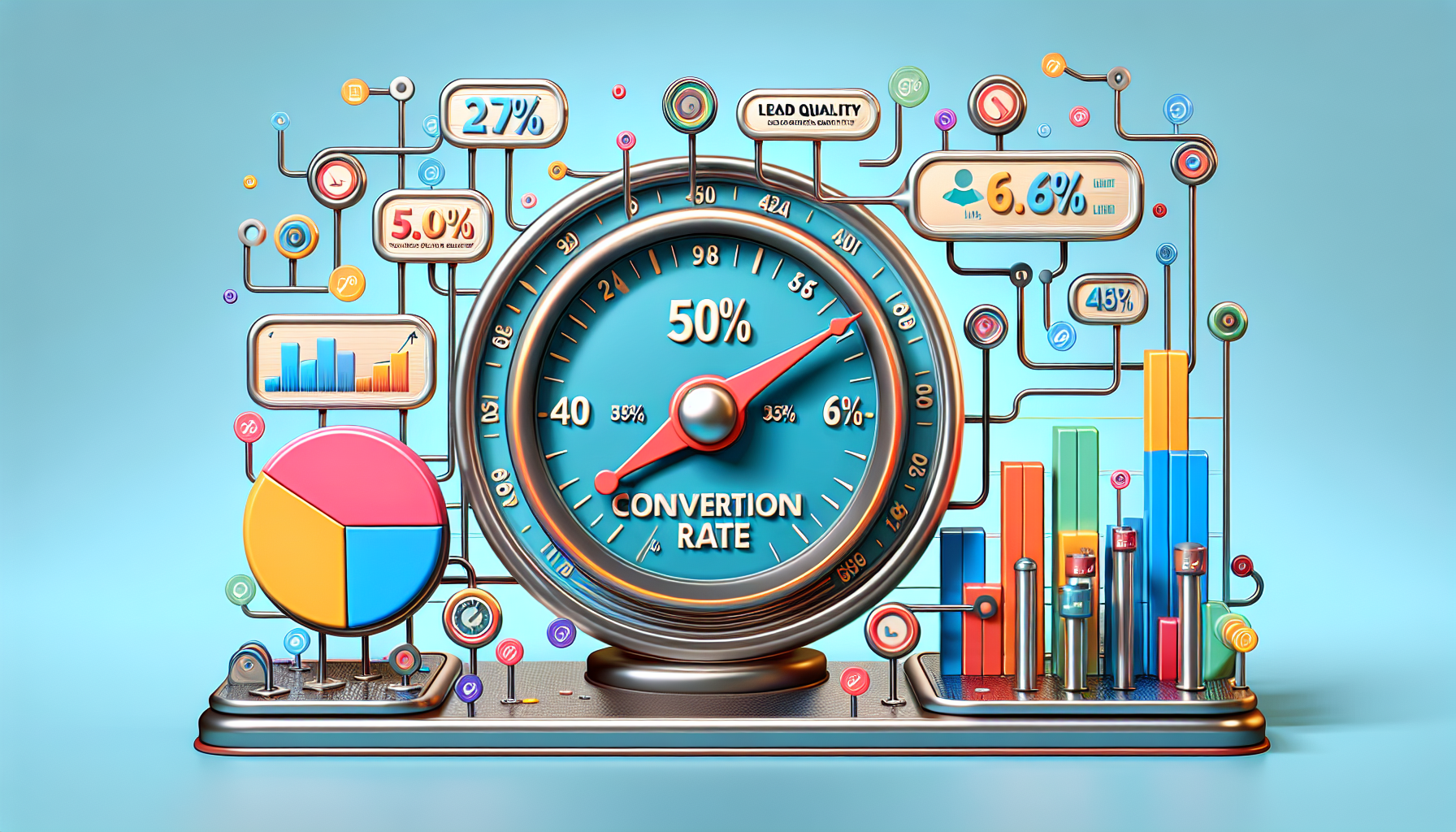Determining your B2B LinkedIn marketing ROI is critical in today’s data-driven marketplace. This article dives straight into the how-to of optimizing ROI, providing strategies rooted in actual data and analytics to enhance your LinkedIn ad campaigns. From targeting with precision to tracking lead conversions, we will equip you with actionable insights to refine your B2B marketing efforts and maximize returns, without any fluff.
Key Takeaways
-
LinkedIn offers precise targeting options, valuable demographics, and professional data within a network of engaged professionals that make it a highly effective platform for B2B advertising and lead generation.
-
Clear marketing objectives aligned with specific stages of the buyer’s journey are essential for optimizing LinkedIn ad campaigns, evidenced through the platform’s structure of awareness, consideration, and conversion goals.
-
A cost-effective LinkedIn advertising strategy involves not only well-targeted and visually engaging content but also the utilization of analytics and conversion tracking tools to refine targeting, assess lead quality, and optimize ad spend for a better ROI.
Understanding B2B LinkedIn Marketing ROI
In the cutthroat business world today, businesses must squeeze the most out of their ROI from LinkedIn ads to thrive. This requires a strategic and data-driven approach to advertising on the platform. B2B marketers stand to benefit from higher advertising budgets and faster approval processes when they demonstrate a direct and positive ROI. Determining this ROI is necessary to validate upcoming marketing investments, and LinkedIn’s Ads ROI calculator simplifies this process.
LinkedIn ads offer distinct advantages over other social media ads, including:
-
More precise targeting options within a professional networking context
-
The ability to reach a highly engaged audience of professionals
-
Access to valuable demographic and professional data for targeting
-
Opportunities for B2B marketing and lead generation
When evaluating ROI, it’s recommended to consider the entire duration of a marketing campaign to understand the full impact of strategies such as branding and customer advocacy.
The Essence of ROI in B2B LinkedIn Campaigns
LinkedIn advertising ROI is a key indicator for B2B marketers as it quantifies the effectiveness of their ad spend in terms of generating profit and achieving marketing goals. Measuring this ROI can be challenging due to factors such as longer, more complex buyer journeys, the involvement of multiple decision-makers, and a variety of goals that extend beyond immediate sales.
Components of LinkedIn Marketing ROI
Key components of LinkedIn marketing ROI include factors like Cost per Lead (CPL) and sales conversion rates. CPL can be deduced by dividing the media investment by the number of leads generated, which can be determined by the number of requests or inquiries received. The number of leads is derived from the number of ad campaign clicks multiplied by the conversion rate from clicks to leads.
Total revenue generated is a critical component, as it quantifies the direct financial impact of the ad campaign.
Setting Clear Marketing Objectives for Your LinkedIn Ad Campaigns

Outlining the purpose of a LinkedIn ad campaign is vital, as it refines the campaign’s direction and informs all subsequent activities, from content formulation to campaign implementation. LinkedIn’s Campaign Manager plays a pivotal role in this process, prompting users to choose a clear marketing objective and ensuring campaigns are optimized for specific goals.
Marketing objectives on LinkedIn are structured into three main categories that correspond to different stages in the marketing funnel: awareness, consideration, and conversions. To define clear marketing objectives, this structure allows for tailored strategies across the buyer’s journey, ensuring campaigns are optimized for maximum effectiveness.
Identifying Campaign Goals
LinkedIn ad campaigns can be optimized by:
-
Selecting ad objectives that align with stages of the marketing funnel, including Awareness, Consideration, and Conversion
-
Refining campaign goals over time by comparing performance to baseline metrics
-
Using A/B testing to identify what adjustments lead to improvements.
A well-articulated call-to-action is essential in directing users towards the campaign’s intended goal, whether it’s to sign up, learn more, or contact the business.
Aligning Objectives with Business Outcomes
It’s vital for companies to align talent leads objectives with business outcomes with an active LinkedIn Recruiter contract. By generating interested candidate leads that support broader company goals, businesses can ensure their LinkedIn campaigns are aligned with their overall strategy and contribute to their greater objectives.
Crafting a Cost-Effective LinkedIn Advertising Strategy

LinkedIn streamlines advertising by prompting users to select campaign objectives at the start, aiding in campaign optimization for better ROI. Developing cost-effective ad campaigns on this platform involves:
-
Creating engaging visuals
-
Clear messaging
-
Personalization for micro-audiences
-
Optimization for mobile users
LinkedIn advertising can prove to be especially effective for small businesses. This platform offers a targeted and professional audience that can lead to higher conversion rates. By targeting niche B2B audiences, these businesses can make strategic budget allocations, thereby achieving better ROI. Testing various LinkedIn bidding strategies is necessary to pinpoint the method that effectively balances cost and results.
Target Audience Selection
To boost ROI, B2B marketers ought to begin by fine-tuning their audience targeting to ensure precision, as ineffective targeting can lead to wasted budget and higher costs per lead. LinkedIn Ads’ targeting capabilities allow advertisers to target audiences accurately based on specifics such as:
-
company name
-
size
-
industry
-
job title
-
skills
-
interests
This ensures that Google Ads reach the most relevant people.
Campaign demographics as part of LinkedIn analytics offer insights into the audience engaging with ads, providing data on job titles, company names, and industries, which can help to optimize ad targeting.
Optimizing Ad Spend
The average cost per click (CPC) for LinkedIn ads is typically $11.03, while in Europe it’s around 6€, indicating regional cost variations. Determining the right budget for a LinkedIn ad campaign requires an assessment of campaign objectives, audience size, and trials at different budget levels. A/B testing is indispensable in LinkedIn advertising for comparing dissimilar ad elements and optimizing campaign strategies to ensure budget efficiency.
Comparing the costs and potential revenue from LinkedIn campaigns to traditional sales efforts can demonstrate the higher efficiency of digital marketing in optimizing ad spend.
Measuring Key Metrics for LinkedIn Ad Performance

Conversion tracking in LinkedIn’s ads manager is imperative to comprehend the business outcomes driven by the ads, such as lead generation, and the ‘Conversion Request to Customer’ percentage helps gauge the effectiveness of these conversions. The Conversion SQL to Request percentage shows that 70% of requests are likely to result in a Sales Qualified Lead, indicating the quality of leads generated from LinkedIn ad campaigns.
LinkedIn Lead Gen Forms, by automating the pre-filling of contact data, significantly reduce friction in the generating leads process, leading to higher conversion rates. LinkedIn’s Direct Sponsored Content enables advertisers to compare the performance of ads across different audience segments in real-time, facilitating quicker and more informed campaign optimization.
The LinkedIn Insight Tag offers the following benefits:
-
Detailed retargeting of website visitors
-
Provides demographic data insights
-
Helps refine and enhance campaign targeting
-
Contributes to increased conversions
Conversion Rate Benchmarks
Benchmark conversion rates for B2B LinkedIn campaigns serve as key indicators of campaign performance, and they help marketers understand how well they are capturing and converting leads in comparison to industry standards. Here are the average conversion rates for B2B LinkedIn campaigns:
-
Click-to-lead conversion rate: 9.23%
-
Lead-to-opportunity conversion rate for LinkedIn ads: 2.63%
-
Opportunity-to-closed-won conversion rate for LinkedIn campaigns: 12.71%
The average conversion rate for LinkedIn ads, as reported by LinkedIn, is 6.1%. This statistic provides insight into the effectiveness of advertising on this platform.
Tracking Lead Quality
Marketing qualified leads (MQLs) are leads that marketing teams consider potential customers based on their engagement with content and online behavior, while sales qualified leads (SQLs) are those that show clear intent to purchase and are prepared to engage with the sales team. SQLs are more advanced in the sales funnel than a marketing qualified lead; they typically represent a higher chance of conversion and therefore have a more direct and immediate impact on return on investment (ROI).
Transforming MQLs into SQLs is a vital process that ensures that the sales team can focus their efforts on leads with a serious buying intent, thus making the overall sales process more efficient and potentially improving ROI.
Enhancing Lead Generation through LinkedIn Ads

Crafting personalized messages is fundamental to generating high-quality leads on LinkedIn. Here are some tips to improve your lead generation campaigns:
-
Offer valuable content
-
Use LinkedIn’s advanced targeting capabilities
-
Utilize a combination of LinkedIn ad formats, such as Sponsored Content, Message Ads, and Text Ads
-
Use features like conversion tracking and LinkedIn Lead Gen Forms to measure bottom-of-funnel lead generation metrics
By following these tips, you can improve the effectiveness of your lead generation campaigns on LinkedIn.
LinkedIn is a premier platform for B2B lead generation, offering robust targeting filters and a professional community that includes key decision-makers and C-suite executives. To achieve consideration objectives such as driving traffic to websites and optimizing for landing page clicks, LinkedIn provides specific objectives like brand awareness, website visits, and lead generation, each optimized for different campaign goals. Once cost per lead is calculated, it’s important to estimate the proportion of these leads that will result in sales qualified leads (SQL) by multiplying the number of leads by the conversion rate to SQL.
Effective Targeting Techniques
LinkedIn Ads enables targeting based on a comprehensive array of attributes including company details, job experience, education, demographics, and member interests. Strategically combining different LinkedIn ad formats like Sponsored Content, Sponsored Messages, Dynamic Ads, Document Ads, and Text Ads can enhance brand visibility and address different audience segments. Crafting a cost-effective LinkedIn advertising strategy involves using the platform’s targeting capabilities to define the audience based on work-related criteria like job titles and ensuring the content is engaging for each persona.
Using the Lookalike Audience feature allows businesses to find new prospects that have similar traits to their existing audience, potentially improving conversion rates. Layering targeting parameters, such as job function, seniority, and skills, can help pinpoint the most promising prospects on LinkedIn. B2B lead generation campaigns should target various parts of an organization rather than focusing solely on executive or managerial levels.
Content Strategies to Engage Prospects
Thought leadership content plays a significant role in lead generation on LinkedIn as it helps to establish authority and credibility. Establishing early value in the buyer’s journey through thought leadership can directly impact decision makers and influencers.
LinkedIn Direct Sponsored Content allows for testing of different messages to determine which content best engages the target audience. Pinpointing resonant messages through testing enhances the campaign’s ROI by fostering better engagement with prospects.
Advanced Analytics: Gauging Campaign Effectiveness
Analysis of campaign data aids in strategy refinement and betterment of future ad performance, leading to a profound understanding of ROI. The accurate interpretation of this data can signal when to reallocate resources to the most effective strategies, thus maximizing the effectiveness of the marketing strategies employed.
Leveraging LinkedIn's Analytics Tools
LinkedIn’s Campaign Manager assists advertisers in tracking campaign performance with key metrics and insights, facilitating the optimization process. Real-time data and demographic insights from LinkedIn Campaign Manager help measure the return on investment of ad campaigns. LinkedIn’s analytics tools measure vital performance indicators including:
-
Clicks
-
Impressions
-
CTR (Click-Through Rate)
-
Engagement
-
Conversions
-
Cost metrics like CPL (Cost Per Lead)
Marketers can compare clicks, impressions, and social actions using LinkedIn’s analytics to identify top-performing campaigns and ad creatives. The Company Engagement Report offers detailed engagement metrics, such as website visits and ad engagement, to gauge interaction with a brand across LinkedIn.
Interpreting Data for Strategic Decisions
Comprehending the correlation between data interpretation and ROI can indicate when to shift resources to more fruitful strategies. Identifying patterns in audience engagement can reveal what content resonates best and at what times, aiding in better campaign timing and content creation. Detecting anomalies in engagement or conversion rates can be crucial indicators for revising targeting parameters or ad copy.
Strategic adjustments entail modifying campaign elements in response to data trends, affecting metrics such as impressions, click-through rates, and conversions. Adjustments based on quantitative data insights can lead to improved targeting, content, and overall campaign effectiveness. Data trends post-adjustment must be tracked and evaluated to see if changes yield improved results or if further revisions are necessary.
Case Studies: Successful B2B LinkedIn Campaigns
A software company used LinkedIn’s precise targeting features to reach decision-makers in relevant industries, resulting in a 150% increase in quality leads and a boost in revenue. By leveraging Sponsored Content and Sponsored InMail, an IT services provider generated a 50% increase in sales leads, attributing a 75% revenue increase directly to LinkedIn campaign efforts.
One B2B company realized the importance of A/B testing ad copy and visuals, leading to a 33% improvement in click-through rates after several iterations. For a technology firm, regular metrics analysis and strategy adjustments based on LinkedIn Insights were pivotal in doubling their conversion rate over six months.
By continuously optimizing their ad targeting criteria, a manufacturing company was able to decrease their cost per lead by 60% while maintaining a strong lead quality.
Campaign Revenue Growth Stories
Some successful examples of LinkedIn marketing campaigns include:
-
AVEPoint, which witnessed a significant ROI, with a five to eight dollar return on every dollar invested in their LinkedIn campaign
-
Autodesk, which successfully utilized LinkedIn Retargeting and Conversation Ads in their Account-Based Marketing (ABM) campaign to connect with new purchasers
-
AstraZeneca, which recorded the highest click-through rate for its product on any social media platform via a branded Sponsored Messaging campaign on LinkedIn
-
Adobe, whose LinkedIn marketing strategy, which focused on collaboration between marketing and sales teams, exceeded their digital event registration expectations
These notable revenue achievements underline the platform’s potential for high ROI in B2B marketing, as businesses often wonder how many customers they can acquire.
Lessons Learned from High-ROI Campaigns
The success of Adobe’s campaign was amplified by effective collaboration between marketing and sales, thus guaranteeing consistent and relevant customer experiences on LinkedIn. BambooHR achieved a 40% enhancement in cost-per-lead efficiency by refining their LinkedIn ad strategy, indicating the importance of continual strategy optimization for efficiency gains.
Autopilot obtained over 500 quality leads within three months by focusing their campaigns on LinkedIn, demonstrating the potential of targeted campaigns for quality lead acquisition. BMG Group effectively reduced their cost per lead by 21% through LinkedIn campaigns, putting an emphasis on the cost-effectiveness of well-targeted advertising efforts.
CloudThat saw an exceptional 287% revenue growth by utilizing Integrately for their LinkedIn Lead Generation Campaigns, showcasing the direct impact of strategic campaign implementation on revenue.
Long-Term ROI Planning: Beyond Immediate Sales
LinkedIn marketing strategies may impact sales cycles that stretch far beyond standard campaign durations, rendering time a significant factor in the accurate assessment of long-term ROI. This understanding emphasizes the importance of long-term strategic planning, which should focus on aspects beyond immediate sales, including building a sustainable sales funnel and prioritizing brand development and customer retention.
Building a Sustainable Sales Funnel
A well-crafted sales funnel is instrumental in turning leads into sales, and a poor conversion rate indicates that the funnel and the overall marketing strategy need to be revised and enhanced.
Regular testing and experimentation with various marketing channels, including LinkedIn, help digital marketers discover which platforms provide the highest long-term ROI, thus contributing to a sustainable sales funnel.
Brand Development and Customer Retention
American International Group improved their brand perception and product awareness through the use of Sponsored Content, InMail, and Display on LinkedIn. Strategic marketing investments that emphasize long-term goals and metrics are crucial for growing business and should be considered when evaluating the ROI of brand development and customer retention efforts.
Summary
By exploring the intricacies of LinkedIn B2B marketing, we’ve gained insights into crafting effective ad campaigns, maximizing ROI, leveraging analytics, and learning from successful case studies. We’ve seen how important it is to set clear marketing objectives, select the right target audience, and optimize ad spend. We have realized the significance of tracking key metrics and enhancing lead generation through effective targeting techniques and engaging content strategies. It’s evident that the benefits of LinkedIn advertising extend beyond immediate sales, and a well-planned, long-term strategy can result in a sustainable sales funnel and robust brand development.
Frequently Asked Questions
Do 80% of B2B social media leads come from LinkedIn?
Yes, 80% of B2B social media leads come from LinkedIn, making it the most lucrative social network for B2B marketers. It goes beyond organic marketing and many marketers utilize LinkedIn ads to connect with their target market.
What is the ROI on LinkedIn ads?
The ROI on LinkedIn ads is calculated by measuring how much money you make for every dollar spent on ads. For instance, if you spend $1000 on ads and generate $3000 in revenue, your advertising ROI would be 200%.
How effective is LinkedIn for B2B marketing?
LinkedIn is highly effective for B2B marketing, as it can reach a large audience, drive purchase intent and higher conversion rates, and generate high-quality leads for 40% of B2B marketers.
What is good B2B marketing ROI?
A good B2B marketing ROI means generating more revenue than the amount spent on marketing. Aim to make more than a dollar for every dollar spent.
How can I maximize the ROI of my LinkedIn ad campaigns?
To maximize the ROI of your LinkedIn ad campaigns, focus on refining audience targeting, crafting engaging content, and optimizing ad spend, while leveraging LinkedIn's analytics tools for campaign tracking and A/B testing for optimization. These steps can help improve your campaign's performance.

 15 min read
15 min read




 4 min read
4 min read

